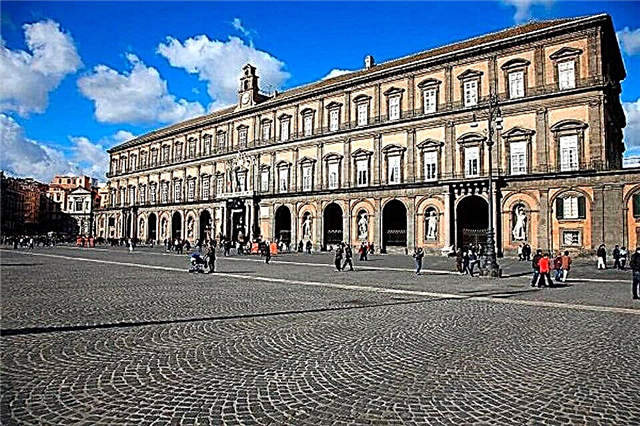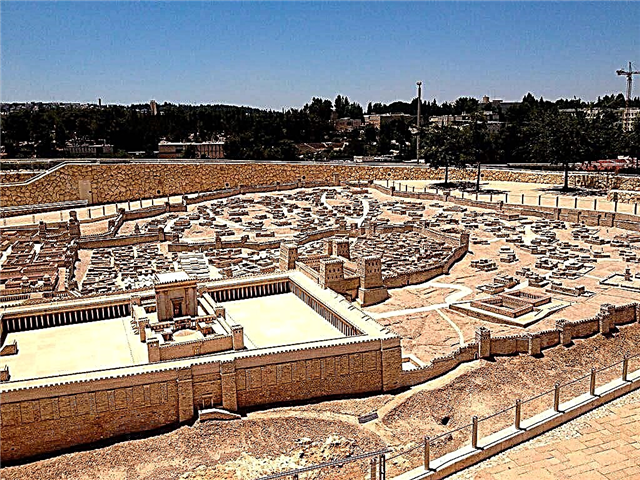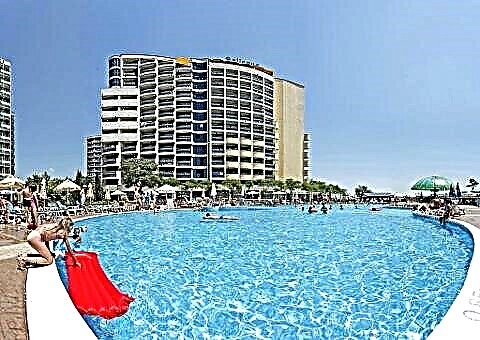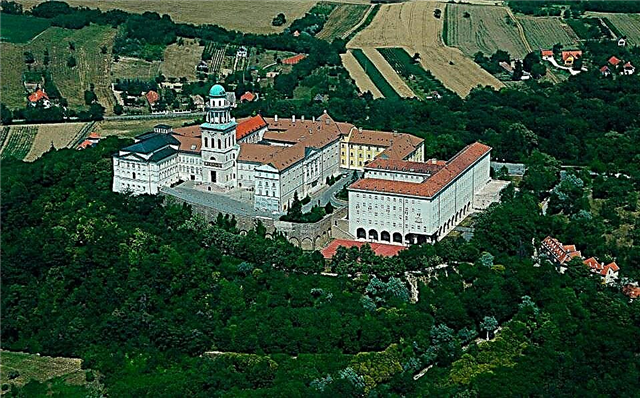Address: Russia, Nizhny Novgorod region, Nizhny Novgorod, Sloboda Pechery street, 124
Start of construction: 1785 year
Completion of construction: 1794 year
Architect: Ananyin Ya.A.
Coordinates: 56 ° 19'08.0 "N 44 ° 04'18.9" E
Content:
On the right bank of the Volga, within the boundaries of the modern city, there is a small five-domed church and a slender tent-roofed bell tower. More than 400 years ago, there was a monastery here, founded by St. Dionysius. But at the end of the 16th century, it was destroyed by a giant landslide. From the caves that once existed here, only the toponyms "Pechera" and "Pecherskaya Sloboda" remain. Today, a long staircase leads to the temple. Believers come here to visit the relics of St. Joasaph, as well as to draw water from a healing spring.

General view of the church
Ancient monastery
In the 30s of the XIV century, the monk Dionysius came to these places from the Kiev-Pechersk Lavra. On the way to the city from the Volga Ponizovye, on the right bank of the river, he dug a cave for himself and began to live alone. After a while, other monks also settled near Dionysius. This is how the Pechersky Ascension Monastery appeared - one of the oldest in the Nizhny Novgorod land.
In June 1597, there was a real natural disaster. A huge landslide descended to the Volga and even changed its course. The layers of earth did not spare anything in their path. They demolished almost all the monastery buildings and opened the entrances to the old caves. The stone Church of the Ascension, the warm church of the Most Holy Theotokos, the high bell tower, the monastery cookery, cells and the fence were destroyed to the ground.
The burial of Schema-monk Joasaph, who had been buried 30 years earlier, was found in clods of upturned earth. The monk's relics turned out to be incorrupt. Tsar Fyodor Ioannovich issued a decree, and the monastery was moved to another coastal site - closer to the city. The new place where the monks settled was about 1.5 km away from the old destroyed buildings up the Volga valley.
Temple history
On the site of the monastery destroyed by the landslide, at first there was a chopped St. Nicholas Church. The platform near it was strengthened, and a coffin with the relics of St. Joasaph was placed inside. In 1640, this church burned down in a fire. At first, a memorial cross was erected on the ashes. And at the end of the 17th century, a new wooden church was cut down. It was necessary because the population around the settlement was increasing. By this time, there were already about 60 peasant households.
Local residents were famous as excellent gardeners. They supplied vegetables, and above all, cucumbers of excellent quality, to the monastery, and later to the Nizhny Novgorod fair.

View of the main entrance and the church bell tower
According to the church reform of 1764, the Staropechersky church, previously assigned to the monastery, became a parish church. In 1782, this church burned down during another big fire, and the inhabitants of the settlement began to petition for the construction of a new church. The Synod issued a permit and allocated 500 state rubles. The rest of the money needed for the construction was collected by the parishioners themselves. While the preparatory work was going on, the parishioners arranged a cave next to the burnt-down building and placed a coffin with the relics of Schema-monk Joasaph in it, which had not been damaged in the fire.
In 1794, a stone church appeared in Pecherskaya Sloboda, built according to the project of the provincial architect Yakov Ananyevich Ananyev. She had three thrones. The main throne was dedicated to the Transfiguration of the Lord, and the side-altars - to St. Nicholas and John the Theologian. It took several more years to make the iconostasis and paint icons.
In 1853, the landslide was repeated. A significant part of the Volga slope broke away from the base and began to move downward, directly onto the temple. However, not reaching it a little, a wide 50 m landslide unexpectedly changed direction and descended to the Volga away from the church.
At the beginning of the 20th century, the large church parish included the village of Pecherskaya Sloboda, as well as the villages of Podnovskaya Sloboda and Kremlevskaya Sloboda. And the total number of peasant households exceeded one thousand.
During the years of Soviet power, many monasteries and churches were closed in the city. The Transfiguration Church remained one of the few in which services were not interrupted. And although it was located quite far from the city center, there were always many believers here. During an active anti-religious campaign, which the Soviet government began in the late 1920s, there were 1,500 people in the Staropechersky parish.

View of the south facade of the church
To undermine the authority of the church among the inhabitants of the settlement, local authorities tried to remove the relics of St. Joasaph from the church. But the parishioners obstructed this decision. Then in March 1929, representatives of the authorities opened the tomb. The local Union of militant atheists demanded chemical experiments on the relics of St. Joasaph. But the parishioners again actively rebuffed.
Government authorities reacted quickly. All priests and the most active inhabitants of the settlement were arrested. The participants in the popular revolt against the desecration of the shrine were declared a "criminal group." They were accused of anti-Soviet activities and sent to northern camps for three years.
The second wave of arrests of clergymen of the Staropechersky Church took place in 1938. Members of the clergy were accused of subversive and espionage work and were shot. Without the priests, the church was virtually closed. The parishioners asked that one or another priest be allowed to hold services. But the regional executive committee opposed every time. Finally, in 1940, the agreement with the parish community was terminated, expelling the believers from the church they owned. There were even plans to convert the cult building into a club. However, the first to settle in the church was the Nizhniy Novgorod Pishchetorg, which for some time used the premises as a vegetable store.
Divine services in the Staropecherskaya Church resumed in August 1943. And the small building could barely accommodate 2,500 parishioners who came to church services. In the post-war period, parishioners paid for repairs, restored wall paintings and built a wooden staircase that connected the Pechera settlement with the city quarters. A little later, central heating was installed inside the church, and a stone baptismal gatehouse was erected next to it. In 1962, a water supply was installed in the Staropecherskaya church.
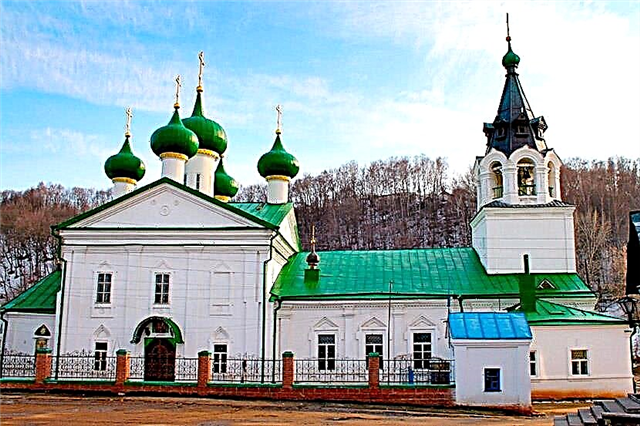
View of the north facade of the church
In the mid-1990s, archaeologists worked on the site of the ancient monastery. They discovered the remains of a monastery churchyard of the XIV-XVI centuries and ceramics from the same period. A facing molding brick dating from the 16th century was also found here.
In 2014, to celebrate the 220th anniversary, the temple was restored inside and outside. In addition, the territory adjacent to the church was ennobled. All these works were carried out within the framework of the large-scale social program "Pechersk Domes".
Architectural features of the church
The Savior Transfiguration Church has hardly changed during its history and has mostly retained its original features. Today it has the status of an architectural monument of the late 18th century.
The church building was built in the tradition of a “ship” temple. The main volume continues with a spacious refectory. And on the west side, the composition stretched out in one line ends with a hipped bell tower. The temple is crowned with five domes with gilded crosses and covered with an eight-pitched gable roof. Although originally the roof over the church was plank and only the heads were covered with sheets of white iron.
There is a spring revered by believers 100 m from the temple, near which a small wooden chapel has been built.
The current state of the temple and the visiting regime
The Orthodox Church is active and is open to all comers every day. The church has a Sunday school for parishioners' children. On Saturdays, the church hosts an Orthodox lecture hall for adults.
Every year on December 2, the day of remembrance of Schema-monk Joasaph is celebrated here. On this day, a festive service is held in the temple.

View of the church Kolcoln
How to get there
The church is located in the Nizhny Novgorod region, next to the Grebnoy canal, in the Pechera settlement, 124. You can drive up to the temple by car along the Grebnoy canal embankment. If you get by buses or fixed-route taxis, then you need to go to the stops "Bear Valley" or "Factory Mayak" ". And then in the direction of the Volga go to the Staropecherskaya church on foot.





